Analyzing Nestle's Strategies in the Global Market
VerifiedAdded on 2020/04/21
|13
|2875
|471
AI Summary
This assignment delves into Nestle’s strategic positioning in the highly competitive global chocolate market, particularly against its rival Cadbury. By examining key strategies such as product innovation, targeted marketing campaigns, effective supply chain management, and competitive pricing, this analysis highlights how Nestle successfully maintains a dominant position. The study incorporates various aspects like market dynamics, brand loyalty, and distribution efficiency to provide a holistic understanding of Nestle's operational excellence and strategic foresight in capturing substantial market share amidst fierce competition.
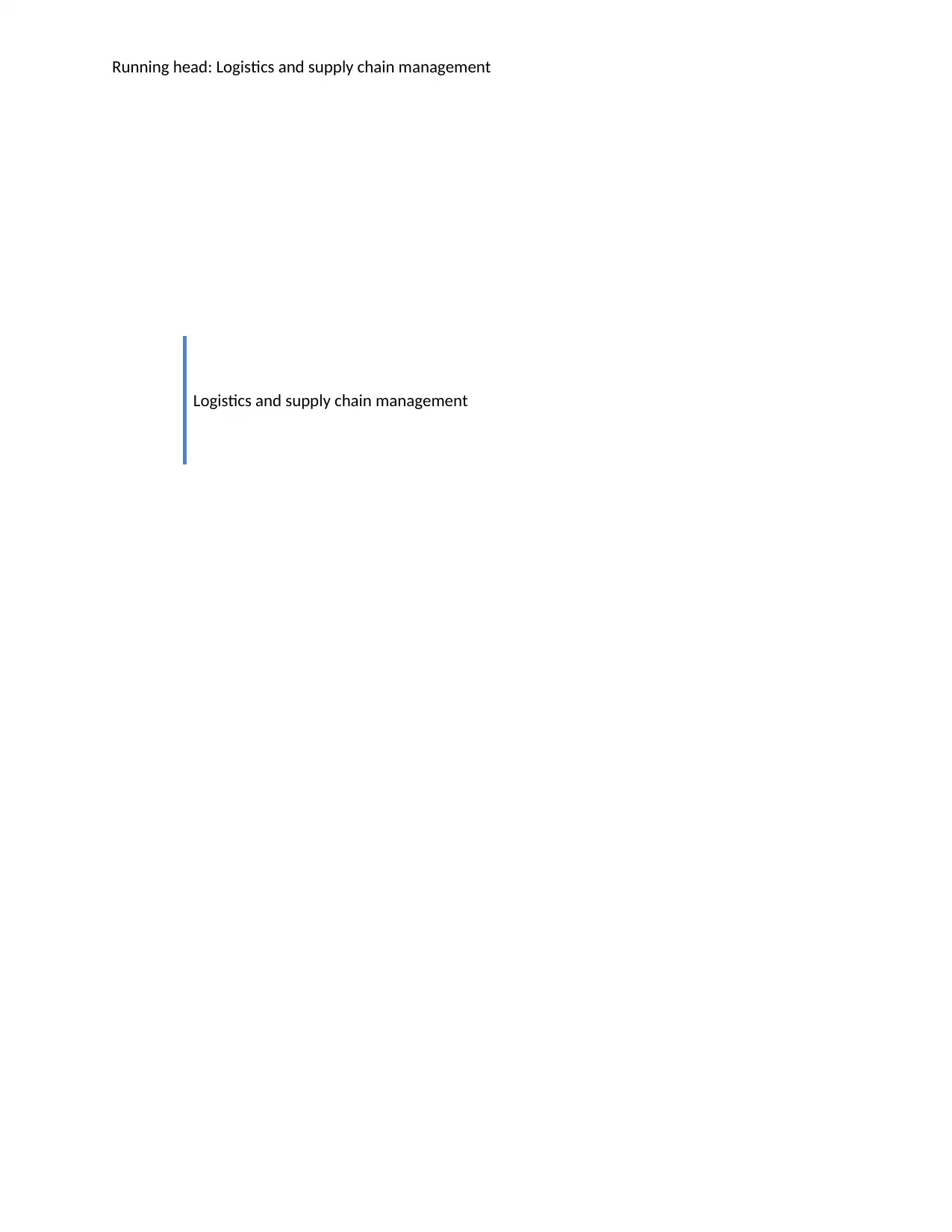
Running head: Logistics and supply chain management
Logistics and supply chain management
Logistics and supply chain management
Paraphrase This Document
Need a fresh take? Get an instant paraphrase of this document with our AI Paraphraser
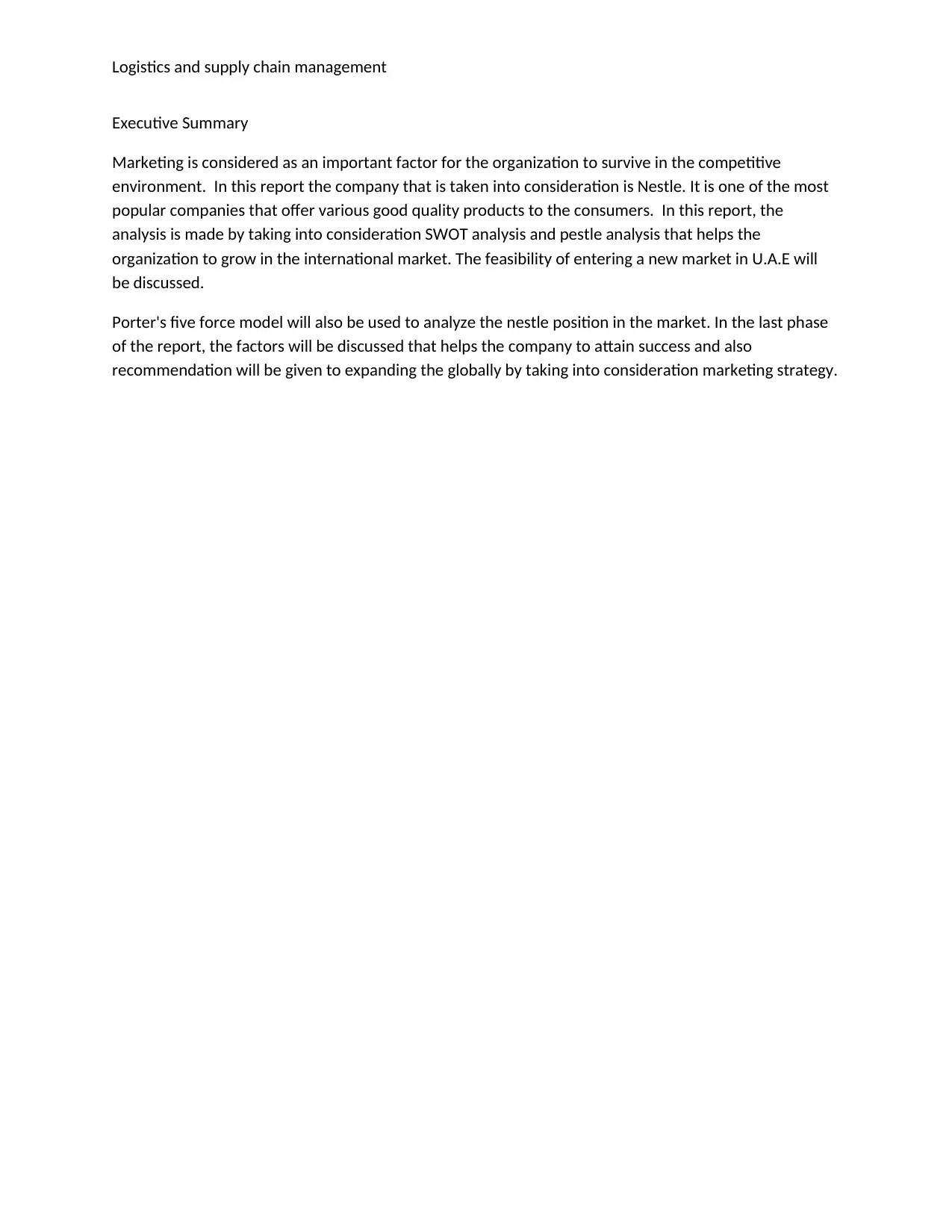
Logistics and supply chain management
Executive Summary
Marketing is considered as an important factor for the organization to survive in the competitive
environment. In this report the company that is taken into consideration is Nestle. It is one of the most
popular companies that offer various good quality products to the consumers. In this report, the
analysis is made by taking into consideration SWOT analysis and pestle analysis that helps the
organization to grow in the international market. The feasibility of entering a new market in U.A.E will
be discussed.
Porter's five force model will also be used to analyze the nestle position in the market. In the last phase
of the report, the factors will be discussed that helps the company to attain success and also
recommendation will be given to expanding the globally by taking into consideration marketing strategy.
Executive Summary
Marketing is considered as an important factor for the organization to survive in the competitive
environment. In this report the company that is taken into consideration is Nestle. It is one of the most
popular companies that offer various good quality products to the consumers. In this report, the
analysis is made by taking into consideration SWOT analysis and pestle analysis that helps the
organization to grow in the international market. The feasibility of entering a new market in U.A.E will
be discussed.
Porter's five force model will also be used to analyze the nestle position in the market. In the last phase
of the report, the factors will be discussed that helps the company to attain success and also
recommendation will be given to expanding the globally by taking into consideration marketing strategy.
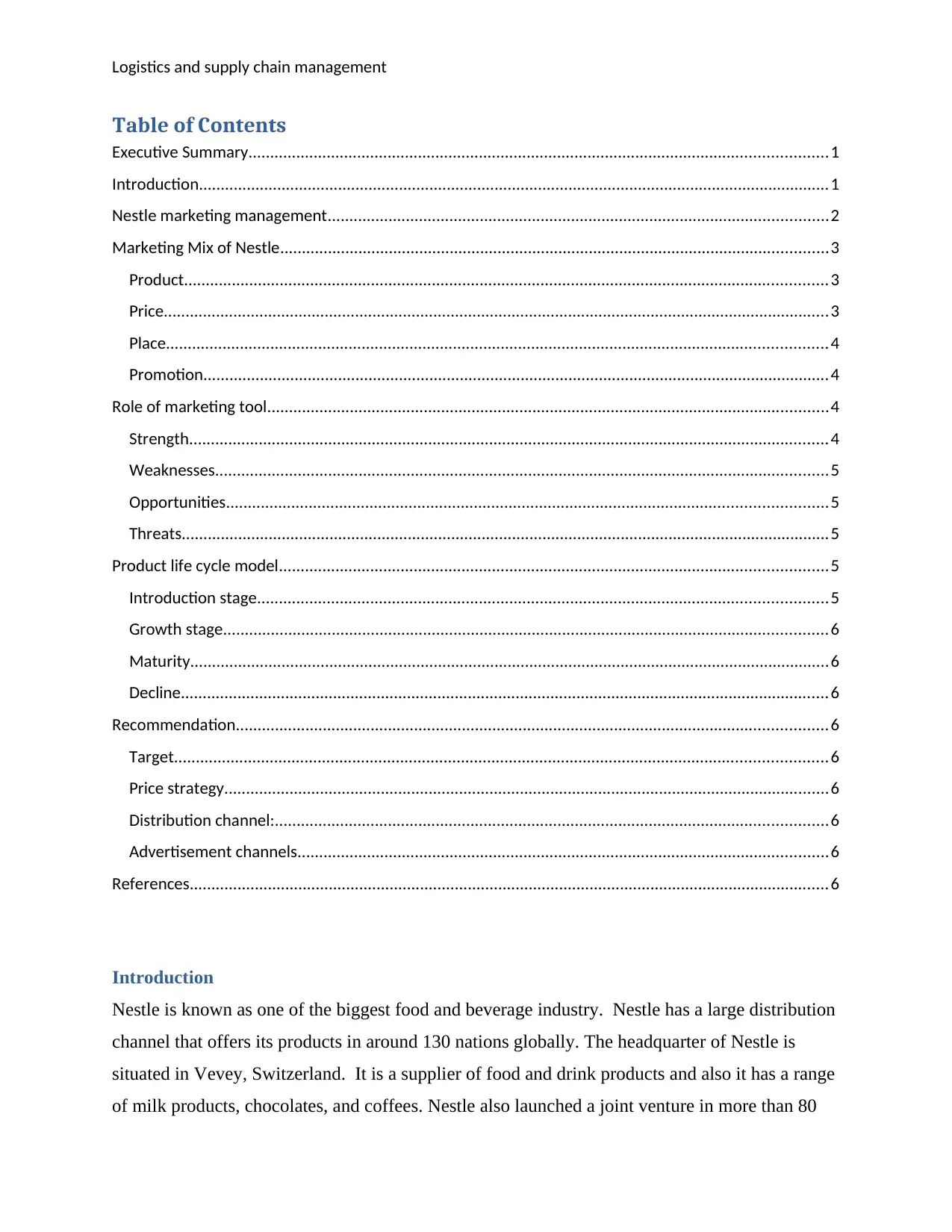
Logistics and supply chain management
Table of Contents
Executive Summary.....................................................................................................................................1
Introduction.................................................................................................................................................1
Nestle marketing management...................................................................................................................2
Marketing Mix of Nestle..............................................................................................................................3
Product....................................................................................................................................................3
Price.........................................................................................................................................................3
Place........................................................................................................................................................4
Promotion................................................................................................................................................4
Role of marketing tool.................................................................................................................................4
Strength...................................................................................................................................................4
Weaknesses.............................................................................................................................................5
Opportunities..........................................................................................................................................5
Threats.....................................................................................................................................................5
Product life cycle model..............................................................................................................................5
Introduction stage...................................................................................................................................5
Growth stage...........................................................................................................................................6
Maturity...................................................................................................................................................6
Decline.....................................................................................................................................................6
Recommendation........................................................................................................................................6
Target......................................................................................................................................................6
Price strategy...........................................................................................................................................6
Distribution channel:...............................................................................................................................6
Advertisement channels..........................................................................................................................6
References...................................................................................................................................................6
Introduction
Nestle is known as one of the biggest food and beverage industry. Nestle has a large distribution
channel that offers its products in around 130 nations globally. The headquarter of Nestle is
situated in Vevey, Switzerland. It is a supplier of food and drink products and also it has a range
of milk products, chocolates, and coffees. Nestle also launched a joint venture in more than 80
Table of Contents
Executive Summary.....................................................................................................................................1
Introduction.................................................................................................................................................1
Nestle marketing management...................................................................................................................2
Marketing Mix of Nestle..............................................................................................................................3
Product....................................................................................................................................................3
Price.........................................................................................................................................................3
Place........................................................................................................................................................4
Promotion................................................................................................................................................4
Role of marketing tool.................................................................................................................................4
Strength...................................................................................................................................................4
Weaknesses.............................................................................................................................................5
Opportunities..........................................................................................................................................5
Threats.....................................................................................................................................................5
Product life cycle model..............................................................................................................................5
Introduction stage...................................................................................................................................5
Growth stage...........................................................................................................................................6
Maturity...................................................................................................................................................6
Decline.....................................................................................................................................................6
Recommendation........................................................................................................................................6
Target......................................................................................................................................................6
Price strategy...........................................................................................................................................6
Distribution channel:...............................................................................................................................6
Advertisement channels..........................................................................................................................6
References...................................................................................................................................................6
Introduction
Nestle is known as one of the biggest food and beverage industry. Nestle has a large distribution
channel that offers its products in around 130 nations globally. The headquarter of Nestle is
situated in Vevey, Switzerland. It is a supplier of food and drink products and also it has a range
of milk products, chocolates, and coffees. Nestle also launched a joint venture in more than 80
⊘ This is a preview!⊘
Do you want full access?
Subscribe today to unlock all pages.

Trusted by 1+ million students worldwide
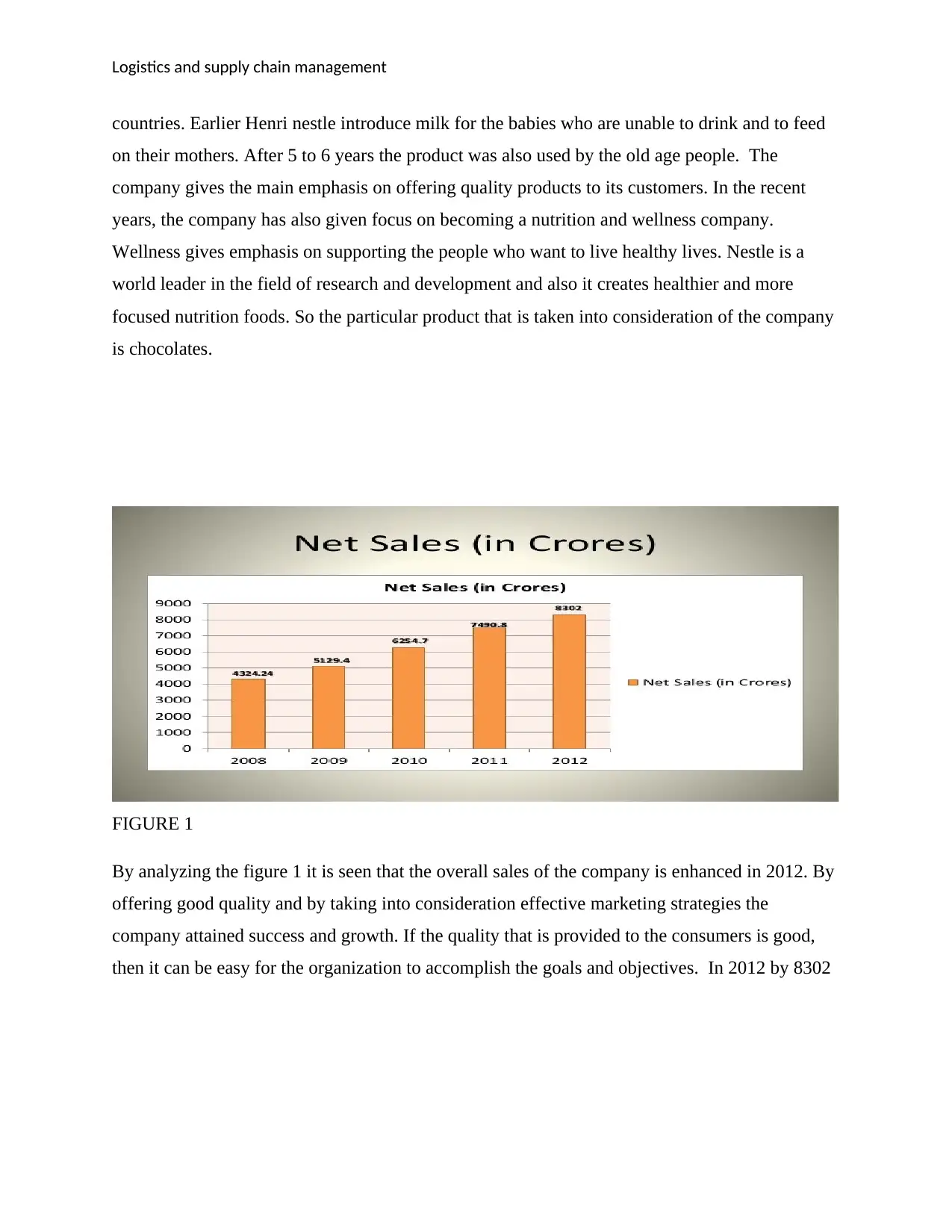
Logistics and supply chain management
countries. Earlier Henri nestle introduce milk for the babies who are unable to drink and to feed
on their mothers. After 5 to 6 years the product was also used by the old age people. The
company gives the main emphasis on offering quality products to its customers. In the recent
years, the company has also given focus on becoming a nutrition and wellness company.
Wellness gives emphasis on supporting the people who want to live healthy lives. Nestle is a
world leader in the field of research and development and also it creates healthier and more
focused nutrition foods. So the particular product that is taken into consideration of the company
is chocolates.
FIGURE 1
By analyzing the figure 1 it is seen that the overall sales of the company is enhanced in 2012. By
offering good quality and by taking into consideration effective marketing strategies the
company attained success and growth. If the quality that is provided to the consumers is good,
then it can be easy for the organization to accomplish the goals and objectives. In 2012 by 8302
countries. Earlier Henri nestle introduce milk for the babies who are unable to drink and to feed
on their mothers. After 5 to 6 years the product was also used by the old age people. The
company gives the main emphasis on offering quality products to its customers. In the recent
years, the company has also given focus on becoming a nutrition and wellness company.
Wellness gives emphasis on supporting the people who want to live healthy lives. Nestle is a
world leader in the field of research and development and also it creates healthier and more
focused nutrition foods. So the particular product that is taken into consideration of the company
is chocolates.
FIGURE 1
By analyzing the figure 1 it is seen that the overall sales of the company is enhanced in 2012. By
offering good quality and by taking into consideration effective marketing strategies the
company attained success and growth. If the quality that is provided to the consumers is good,
then it can be easy for the organization to accomplish the goals and objectives. In 2012 by 8302
Paraphrase This Document
Need a fresh take? Get an instant paraphrase of this document with our AI Paraphraser
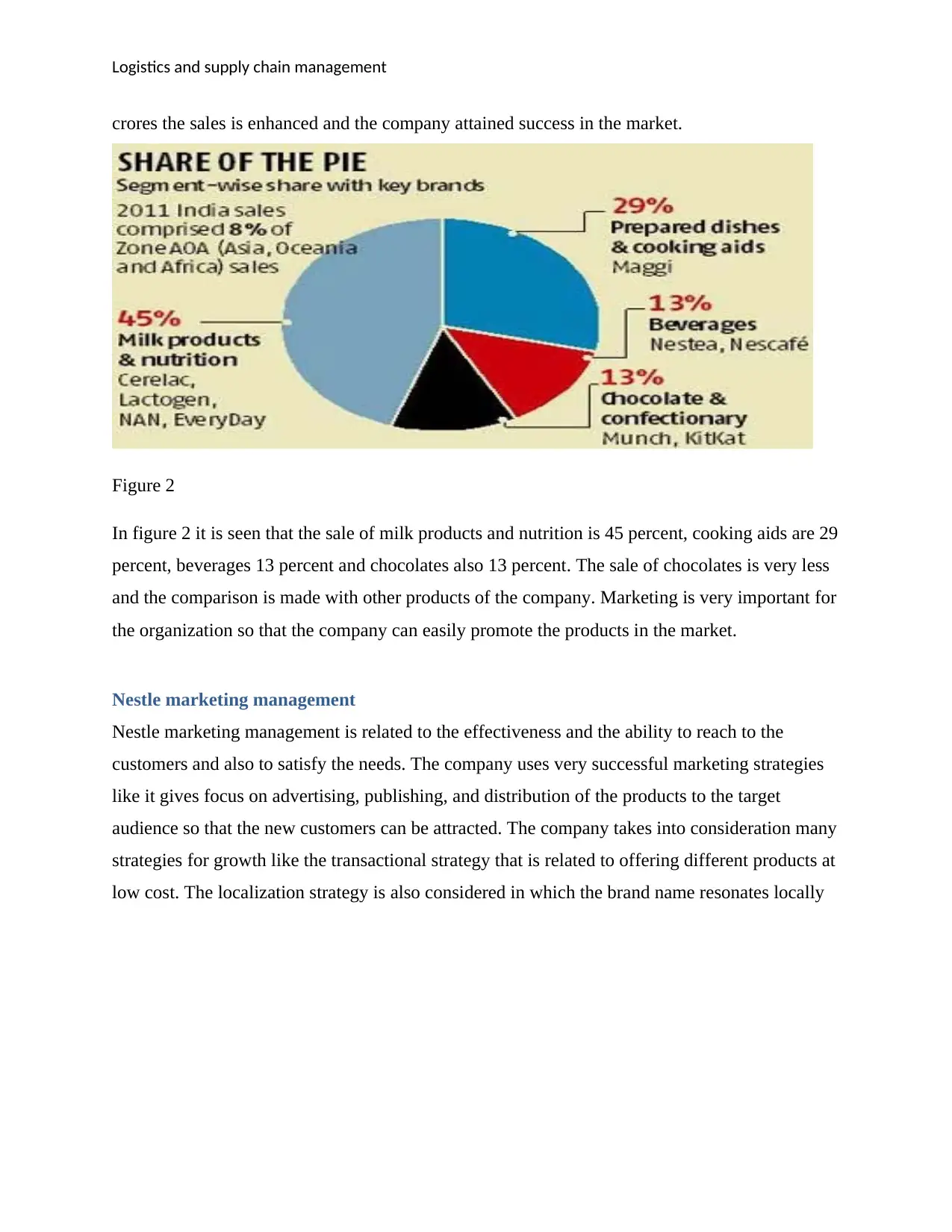
Logistics and supply chain management
crores the sales is enhanced and the company attained success in the market.
Figure 2
In figure 2 it is seen that the sale of milk products and nutrition is 45 percent, cooking aids are 29
percent, beverages 13 percent and chocolates also 13 percent. The sale of chocolates is very less
and the comparison is made with other products of the company. Marketing is very important for
the organization so that the company can easily promote the products in the market.
Nestle marketing management
Nestle marketing management is related to the effectiveness and the ability to reach to the
customers and also to satisfy the needs. The company uses very successful marketing strategies
like it gives focus on advertising, publishing, and distribution of the products to the target
audience so that the new customers can be attracted. The company takes into consideration many
strategies for growth like the transactional strategy that is related to offering different products at
low cost. The localization strategy is also considered in which the brand name resonates locally
crores the sales is enhanced and the company attained success in the market.
Figure 2
In figure 2 it is seen that the sale of milk products and nutrition is 45 percent, cooking aids are 29
percent, beverages 13 percent and chocolates also 13 percent. The sale of chocolates is very less
and the comparison is made with other products of the company. Marketing is very important for
the organization so that the company can easily promote the products in the market.
Nestle marketing management
Nestle marketing management is related to the effectiveness and the ability to reach to the
customers and also to satisfy the needs. The company uses very successful marketing strategies
like it gives focus on advertising, publishing, and distribution of the products to the target
audience so that the new customers can be attracted. The company takes into consideration many
strategies for growth like the transactional strategy that is related to offering different products at
low cost. The localization strategy is also considered in which the brand name resonates locally
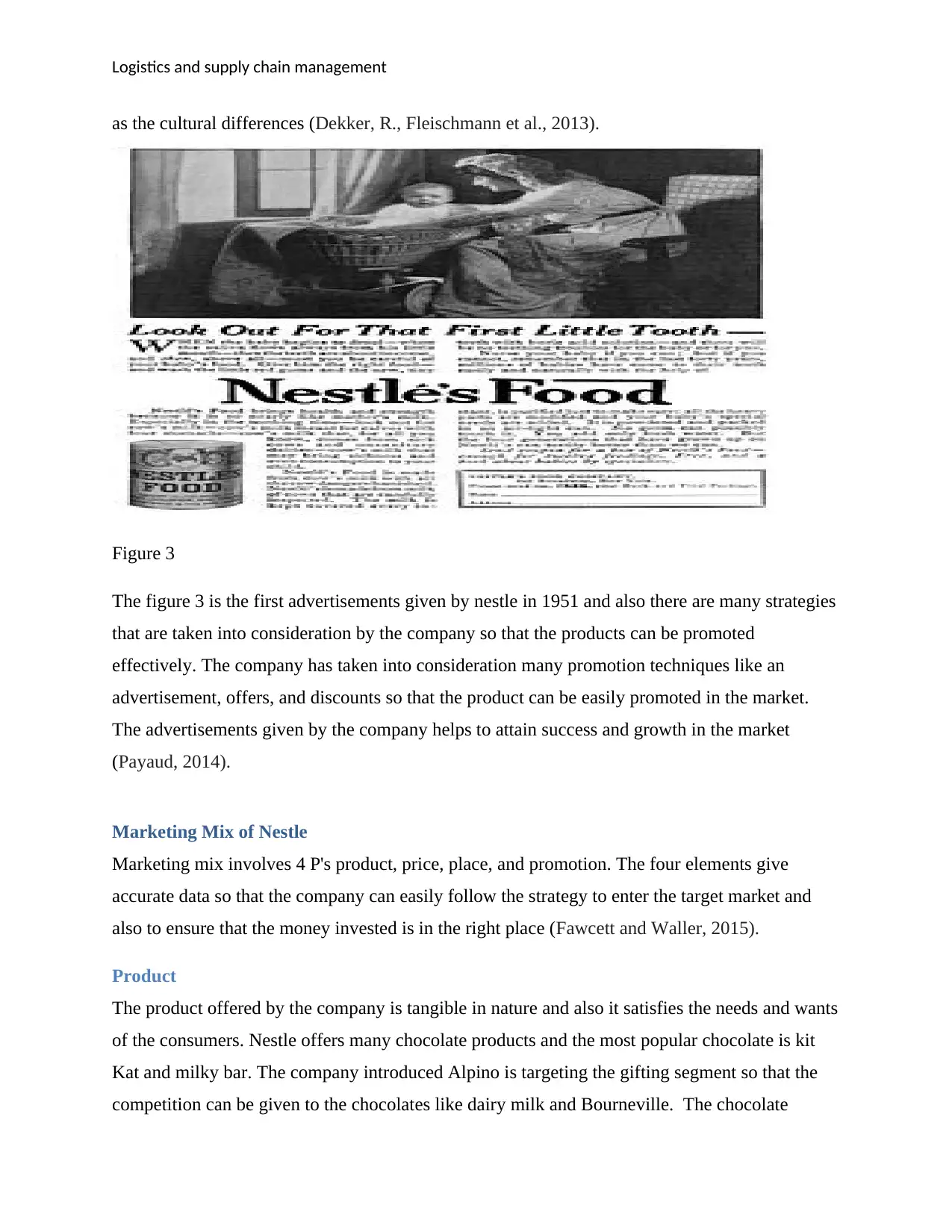
Logistics and supply chain management
as the cultural differences (Dekker, R., Fleischmann et al., 2013).
Figure 3
The figure 3 is the first advertisements given by nestle in 1951 and also there are many strategies
that are taken into consideration by the company so that the products can be promoted
effectively. The company has taken into consideration many promotion techniques like an
advertisement, offers, and discounts so that the product can be easily promoted in the market.
The advertisements given by the company helps to attain success and growth in the market
(Payaud, 2014).
Marketing Mix of Nestle
Marketing mix involves 4 P's product, price, place, and promotion. The four elements give
accurate data so that the company can easily follow the strategy to enter the target market and
also to ensure that the money invested is in the right place (Fawcett and Waller, 2015).
Product
The product offered by the company is tangible in nature and also it satisfies the needs and wants
of the consumers. Nestle offers many chocolate products and the most popular chocolate is kit
Kat and milky bar. The company introduced Alpino is targeting the gifting segment so that the
competition can be given to the chocolates like dairy milk and Bourneville. The chocolate
as the cultural differences (Dekker, R., Fleischmann et al., 2013).
Figure 3
The figure 3 is the first advertisements given by nestle in 1951 and also there are many strategies
that are taken into consideration by the company so that the products can be promoted
effectively. The company has taken into consideration many promotion techniques like an
advertisement, offers, and discounts so that the product can be easily promoted in the market.
The advertisements given by the company helps to attain success and growth in the market
(Payaud, 2014).
Marketing Mix of Nestle
Marketing mix involves 4 P's product, price, place, and promotion. The four elements give
accurate data so that the company can easily follow the strategy to enter the target market and
also to ensure that the money invested is in the right place (Fawcett and Waller, 2015).
Product
The product offered by the company is tangible in nature and also it satisfies the needs and wants
of the consumers. Nestle offers many chocolate products and the most popular chocolate is kit
Kat and milky bar. The company introduced Alpino is targeting the gifting segment so that the
competition can be given to the chocolates like dairy milk and Bourneville. The chocolate
⊘ This is a preview!⊘
Do you want full access?
Subscribe today to unlock all pages.

Trusted by 1+ million students worldwide
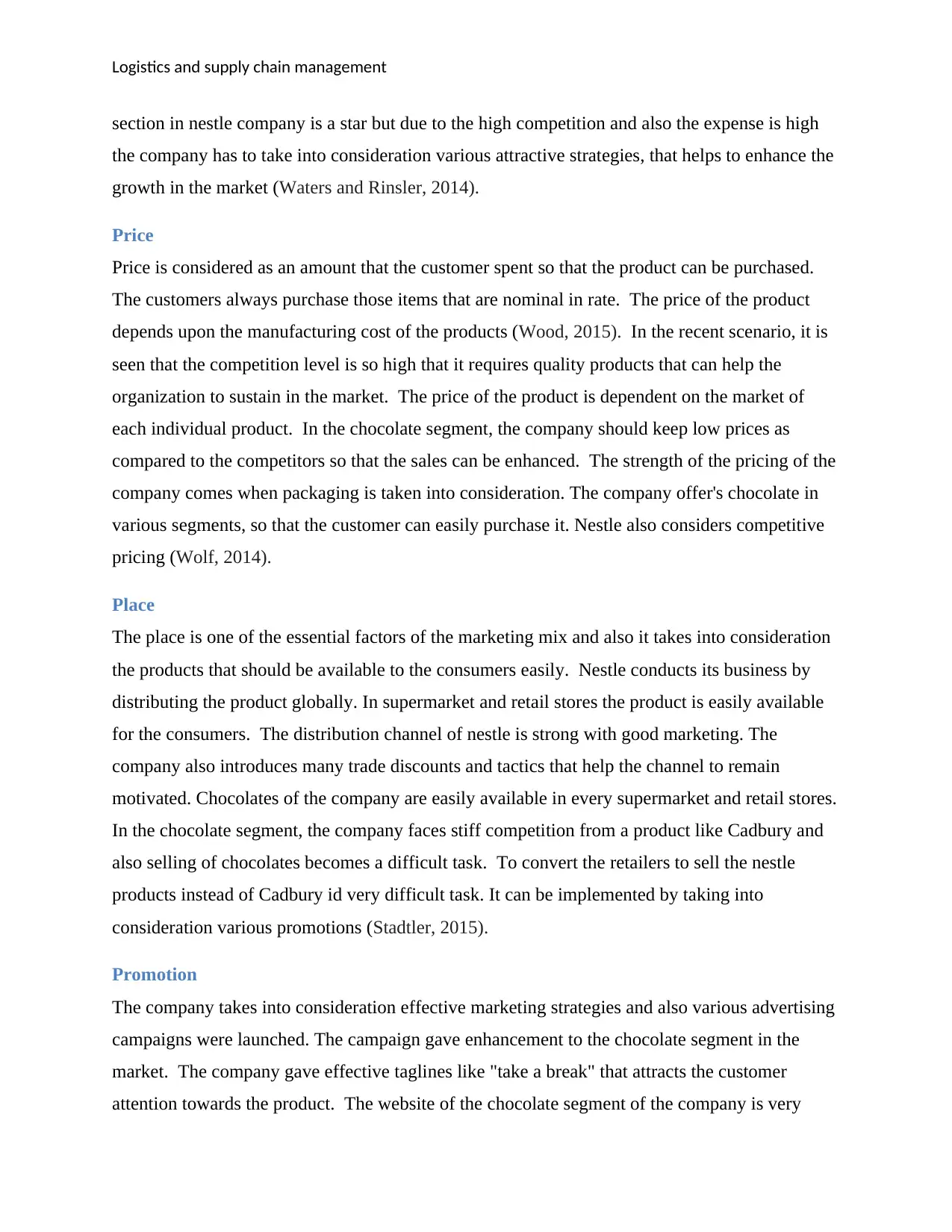
Logistics and supply chain management
section in nestle company is a star but due to the high competition and also the expense is high
the company has to take into consideration various attractive strategies, that helps to enhance the
growth in the market (Waters and Rinsler, 2014).
Price
Price is considered as an amount that the customer spent so that the product can be purchased.
The customers always purchase those items that are nominal in rate. The price of the product
depends upon the manufacturing cost of the products (Wood, 2015). In the recent scenario, it is
seen that the competition level is so high that it requires quality products that can help the
organization to sustain in the market. The price of the product is dependent on the market of
each individual product. In the chocolate segment, the company should keep low prices as
compared to the competitors so that the sales can be enhanced. The strength of the pricing of the
company comes when packaging is taken into consideration. The company offer's chocolate in
various segments, so that the customer can easily purchase it. Nestle also considers competitive
pricing (Wolf, 2014).
Place
The place is one of the essential factors of the marketing mix and also it takes into consideration
the products that should be available to the consumers easily. Nestle conducts its business by
distributing the product globally. In supermarket and retail stores the product is easily available
for the consumers. The distribution channel of nestle is strong with good marketing. The
company also introduces many trade discounts and tactics that help the channel to remain
motivated. Chocolates of the company are easily available in every supermarket and retail stores.
In the chocolate segment, the company faces stiff competition from a product like Cadbury and
also selling of chocolates becomes a difficult task. To convert the retailers to sell the nestle
products instead of Cadbury id very difficult task. It can be implemented by taking into
consideration various promotions (Stadtler, 2015).
Promotion
The company takes into consideration effective marketing strategies and also various advertising
campaigns were launched. The campaign gave enhancement to the chocolate segment in the
market. The company gave effective taglines like "take a break" that attracts the customer
attention towards the product. The website of the chocolate segment of the company is very
section in nestle company is a star but due to the high competition and also the expense is high
the company has to take into consideration various attractive strategies, that helps to enhance the
growth in the market (Waters and Rinsler, 2014).
Price
Price is considered as an amount that the customer spent so that the product can be purchased.
The customers always purchase those items that are nominal in rate. The price of the product
depends upon the manufacturing cost of the products (Wood, 2015). In the recent scenario, it is
seen that the competition level is so high that it requires quality products that can help the
organization to sustain in the market. The price of the product is dependent on the market of
each individual product. In the chocolate segment, the company should keep low prices as
compared to the competitors so that the sales can be enhanced. The strength of the pricing of the
company comes when packaging is taken into consideration. The company offer's chocolate in
various segments, so that the customer can easily purchase it. Nestle also considers competitive
pricing (Wolf, 2014).
Place
The place is one of the essential factors of the marketing mix and also it takes into consideration
the products that should be available to the consumers easily. Nestle conducts its business by
distributing the product globally. In supermarket and retail stores the product is easily available
for the consumers. The distribution channel of nestle is strong with good marketing. The
company also introduces many trade discounts and tactics that help the channel to remain
motivated. Chocolates of the company are easily available in every supermarket and retail stores.
In the chocolate segment, the company faces stiff competition from a product like Cadbury and
also selling of chocolates becomes a difficult task. To convert the retailers to sell the nestle
products instead of Cadbury id very difficult task. It can be implemented by taking into
consideration various promotions (Stadtler, 2015).
Promotion
The company takes into consideration effective marketing strategies and also various advertising
campaigns were launched. The campaign gave enhancement to the chocolate segment in the
market. The company gave effective taglines like "take a break" that attracts the customer
attention towards the product. The website of the chocolate segment of the company is very
Paraphrase This Document
Need a fresh take? Get an instant paraphrase of this document with our AI Paraphraser
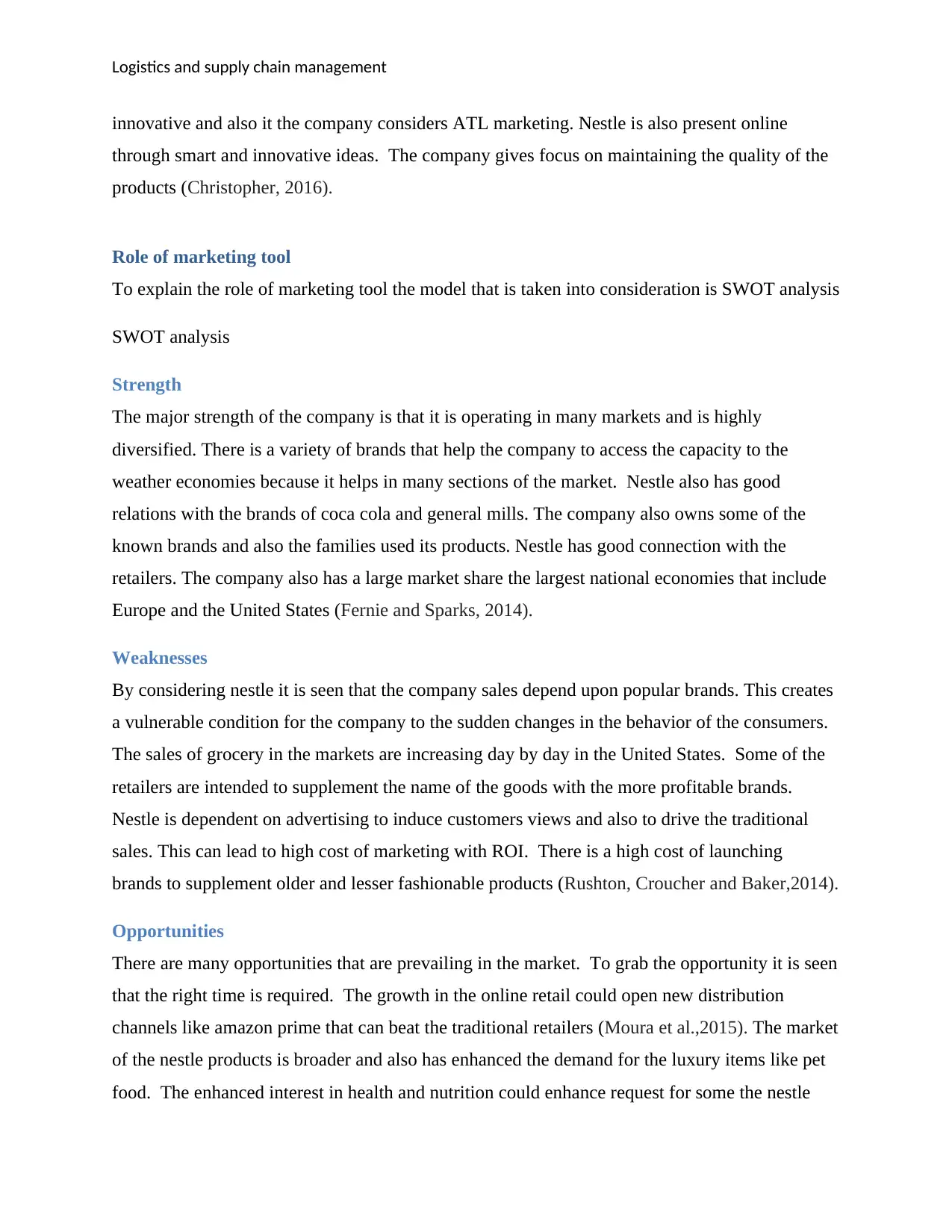
Logistics and supply chain management
innovative and also it the company considers ATL marketing. Nestle is also present online
through smart and innovative ideas. The company gives focus on maintaining the quality of the
products (Christopher, 2016).
Role of marketing tool
To explain the role of marketing tool the model that is taken into consideration is SWOT analysis
SWOT analysis
Strength
The major strength of the company is that it is operating in many markets and is highly
diversified. There is a variety of brands that help the company to access the capacity to the
weather economies because it helps in many sections of the market. Nestle also has good
relations with the brands of coca cola and general mills. The company also owns some of the
known brands and also the families used its products. Nestle has good connection with the
retailers. The company also has a large market share the largest national economies that include
Europe and the United States (Fernie and Sparks, 2014).
Weaknesses
By considering nestle it is seen that the company sales depend upon popular brands. This creates
a vulnerable condition for the company to the sudden changes in the behavior of the consumers.
The sales of grocery in the markets are increasing day by day in the United States. Some of the
retailers are intended to supplement the name of the goods with the more profitable brands.
Nestle is dependent on advertising to induce customers views and also to drive the traditional
sales. This can lead to high cost of marketing with ROI. There is a high cost of launching
brands to supplement older and lesser fashionable products (Rushton, Croucher and Baker,2014).
Opportunities
There are many opportunities that are prevailing in the market. To grab the opportunity it is seen
that the right time is required. The growth in the online retail could open new distribution
channels like amazon prime that can beat the traditional retailers (Moura et al.,2015). The market
of the nestle products is broader and also has enhanced the demand for the luxury items like pet
food. The enhanced interest in health and nutrition could enhance request for some the nestle
innovative and also it the company considers ATL marketing. Nestle is also present online
through smart and innovative ideas. The company gives focus on maintaining the quality of the
products (Christopher, 2016).
Role of marketing tool
To explain the role of marketing tool the model that is taken into consideration is SWOT analysis
SWOT analysis
Strength
The major strength of the company is that it is operating in many markets and is highly
diversified. There is a variety of brands that help the company to access the capacity to the
weather economies because it helps in many sections of the market. Nestle also has good
relations with the brands of coca cola and general mills. The company also owns some of the
known brands and also the families used its products. Nestle has good connection with the
retailers. The company also has a large market share the largest national economies that include
Europe and the United States (Fernie and Sparks, 2014).
Weaknesses
By considering nestle it is seen that the company sales depend upon popular brands. This creates
a vulnerable condition for the company to the sudden changes in the behavior of the consumers.
The sales of grocery in the markets are increasing day by day in the United States. Some of the
retailers are intended to supplement the name of the goods with the more profitable brands.
Nestle is dependent on advertising to induce customers views and also to drive the traditional
sales. This can lead to high cost of marketing with ROI. There is a high cost of launching
brands to supplement older and lesser fashionable products (Rushton, Croucher and Baker,2014).
Opportunities
There are many opportunities that are prevailing in the market. To grab the opportunity it is seen
that the right time is required. The growth in the online retail could open new distribution
channels like amazon prime that can beat the traditional retailers (Moura et al.,2015). The market
of the nestle products is broader and also has enhanced the demand for the luxury items like pet
food. The enhanced interest in health and nutrition could enhance request for some the nestle
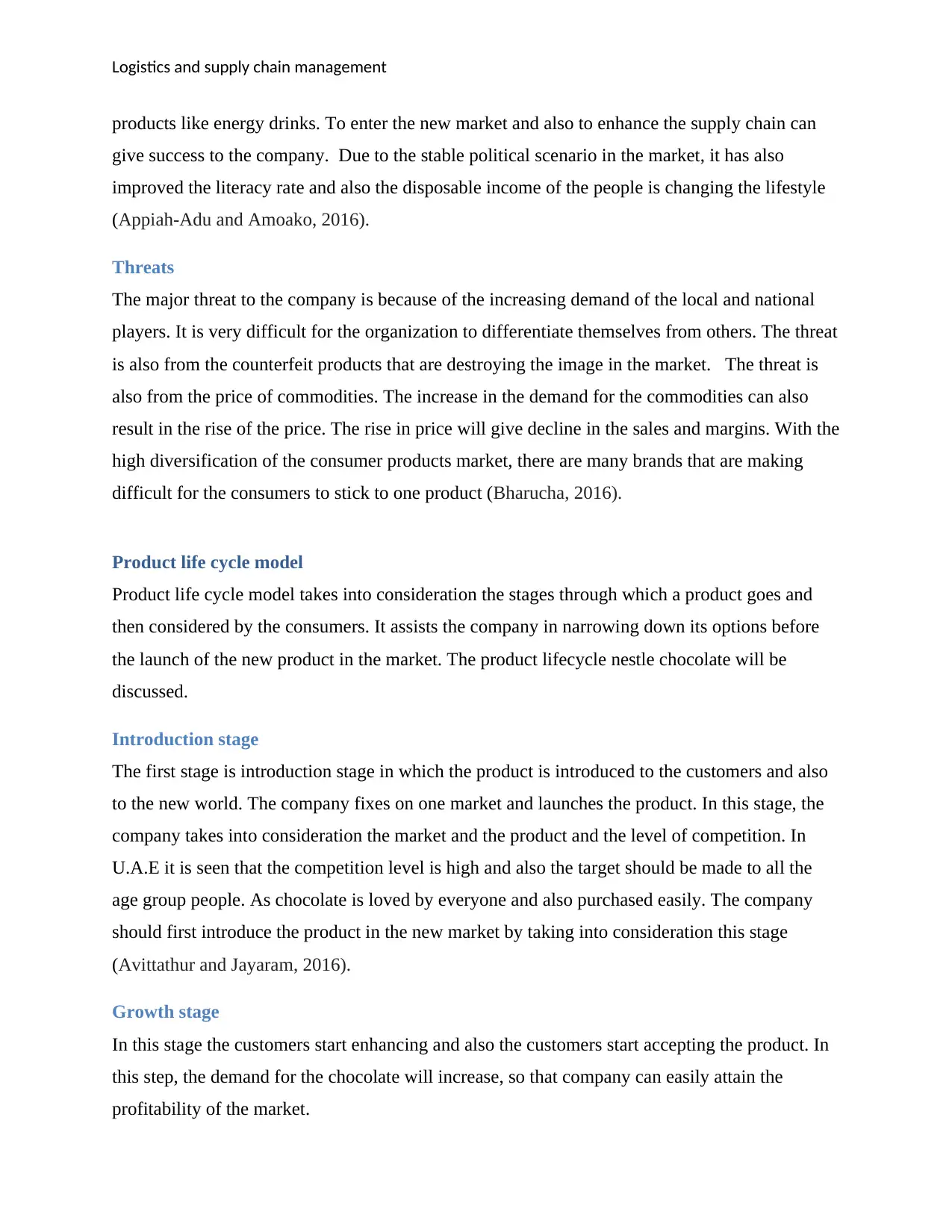
Logistics and supply chain management
products like energy drinks. To enter the new market and also to enhance the supply chain can
give success to the company. Due to the stable political scenario in the market, it has also
improved the literacy rate and also the disposable income of the people is changing the lifestyle
(Appiah-Adu and Amoako, 2016).
Threats
The major threat to the company is because of the increasing demand of the local and national
players. It is very difficult for the organization to differentiate themselves from others. The threat
is also from the counterfeit products that are destroying the image in the market. The threat is
also from the price of commodities. The increase in the demand for the commodities can also
result in the rise of the price. The rise in price will give decline in the sales and margins. With the
high diversification of the consumer products market, there are many brands that are making
difficult for the consumers to stick to one product (Bharucha, 2016).
Product life cycle model
Product life cycle model takes into consideration the stages through which a product goes and
then considered by the consumers. It assists the company in narrowing down its options before
the launch of the new product in the market. The product lifecycle nestle chocolate will be
discussed.
Introduction stage
The first stage is introduction stage in which the product is introduced to the customers and also
to the new world. The company fixes on one market and launches the product. In this stage, the
company takes into consideration the market and the product and the level of competition. In
U.A.E it is seen that the competition level is high and also the target should be made to all the
age group people. As chocolate is loved by everyone and also purchased easily. The company
should first introduce the product in the new market by taking into consideration this stage
(Avittathur and Jayaram, 2016).
Growth stage
In this stage the customers start enhancing and also the customers start accepting the product. In
this step, the demand for the chocolate will increase, so that company can easily attain the
profitability of the market.
products like energy drinks. To enter the new market and also to enhance the supply chain can
give success to the company. Due to the stable political scenario in the market, it has also
improved the literacy rate and also the disposable income of the people is changing the lifestyle
(Appiah-Adu and Amoako, 2016).
Threats
The major threat to the company is because of the increasing demand of the local and national
players. It is very difficult for the organization to differentiate themselves from others. The threat
is also from the counterfeit products that are destroying the image in the market. The threat is
also from the price of commodities. The increase in the demand for the commodities can also
result in the rise of the price. The rise in price will give decline in the sales and margins. With the
high diversification of the consumer products market, there are many brands that are making
difficult for the consumers to stick to one product (Bharucha, 2016).
Product life cycle model
Product life cycle model takes into consideration the stages through which a product goes and
then considered by the consumers. It assists the company in narrowing down its options before
the launch of the new product in the market. The product lifecycle nestle chocolate will be
discussed.
Introduction stage
The first stage is introduction stage in which the product is introduced to the customers and also
to the new world. The company fixes on one market and launches the product. In this stage, the
company takes into consideration the market and the product and the level of competition. In
U.A.E it is seen that the competition level is high and also the target should be made to all the
age group people. As chocolate is loved by everyone and also purchased easily. The company
should first introduce the product in the new market by taking into consideration this stage
(Avittathur and Jayaram, 2016).
Growth stage
In this stage the customers start enhancing and also the customers start accepting the product. In
this step, the demand for the chocolate will increase, so that company can easily attain the
profitability of the market.
⊘ This is a preview!⊘
Do you want full access?
Subscribe today to unlock all pages.

Trusted by 1+ million students worldwide
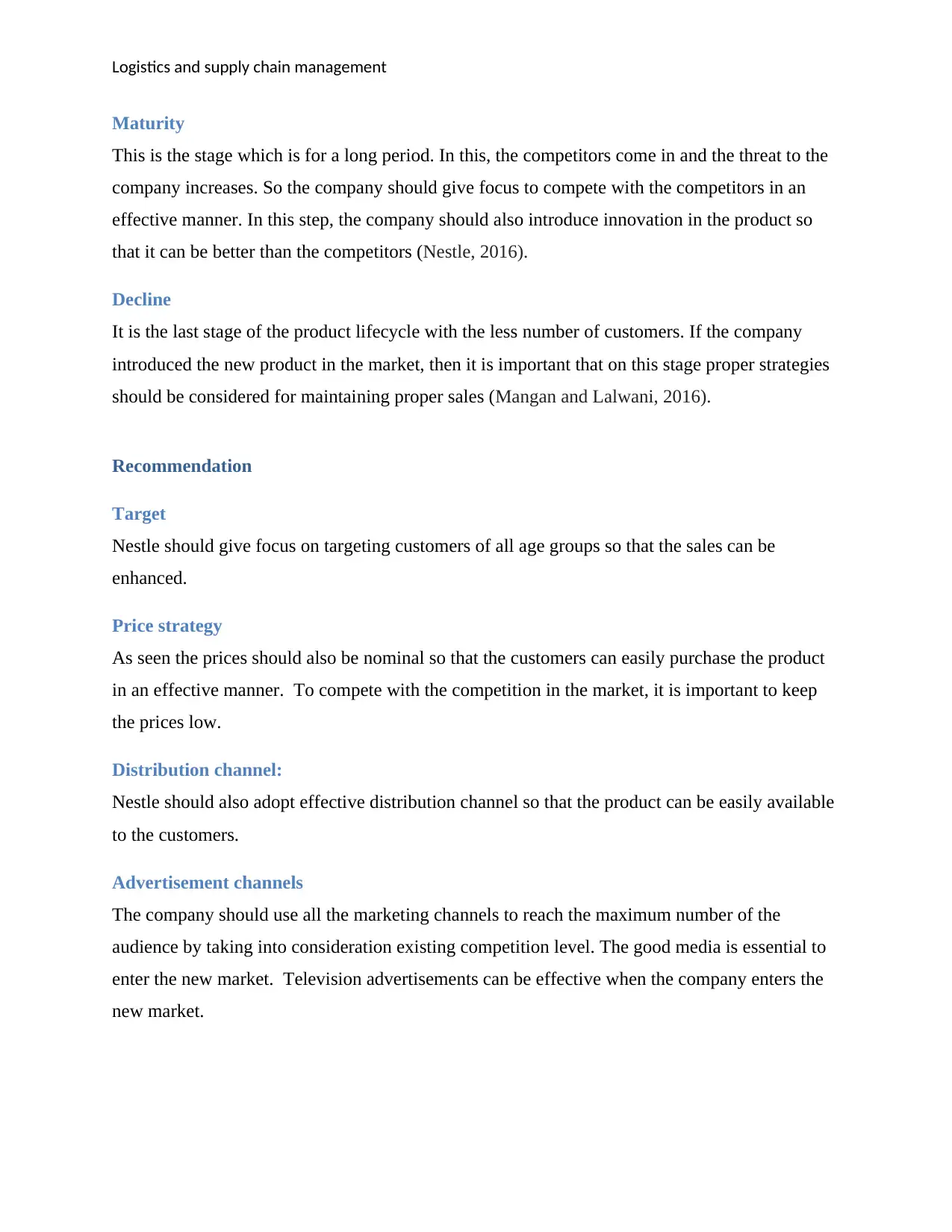
Logistics and supply chain management
Maturity
This is the stage which is for a long period. In this, the competitors come in and the threat to the
company increases. So the company should give focus to compete with the competitors in an
effective manner. In this step, the company should also introduce innovation in the product so
that it can be better than the competitors (Nestle, 2016).
Decline
It is the last stage of the product lifecycle with the less number of customers. If the company
introduced the new product in the market, then it is important that on this stage proper strategies
should be considered for maintaining proper sales (Mangan and Lalwani, 2016).
Recommendation
Target
Nestle should give focus on targeting customers of all age groups so that the sales can be
enhanced.
Price strategy
As seen the prices should also be nominal so that the customers can easily purchase the product
in an effective manner. To compete with the competition in the market, it is important to keep
the prices low.
Distribution channel:
Nestle should also adopt effective distribution channel so that the product can be easily available
to the customers.
Advertisement channels
The company should use all the marketing channels to reach the maximum number of the
audience by taking into consideration existing competition level. The good media is essential to
enter the new market. Television advertisements can be effective when the company enters the
new market.
Maturity
This is the stage which is for a long period. In this, the competitors come in and the threat to the
company increases. So the company should give focus to compete with the competitors in an
effective manner. In this step, the company should also introduce innovation in the product so
that it can be better than the competitors (Nestle, 2016).
Decline
It is the last stage of the product lifecycle with the less number of customers. If the company
introduced the new product in the market, then it is important that on this stage proper strategies
should be considered for maintaining proper sales (Mangan and Lalwani, 2016).
Recommendation
Target
Nestle should give focus on targeting customers of all age groups so that the sales can be
enhanced.
Price strategy
As seen the prices should also be nominal so that the customers can easily purchase the product
in an effective manner. To compete with the competition in the market, it is important to keep
the prices low.
Distribution channel:
Nestle should also adopt effective distribution channel so that the product can be easily available
to the customers.
Advertisement channels
The company should use all the marketing channels to reach the maximum number of the
audience by taking into consideration existing competition level. The good media is essential to
enter the new market. Television advertisements can be effective when the company enters the
new market.
Paraphrase This Document
Need a fresh take? Get an instant paraphrase of this document with our AI Paraphraser

Logistics and supply chain management
References
References
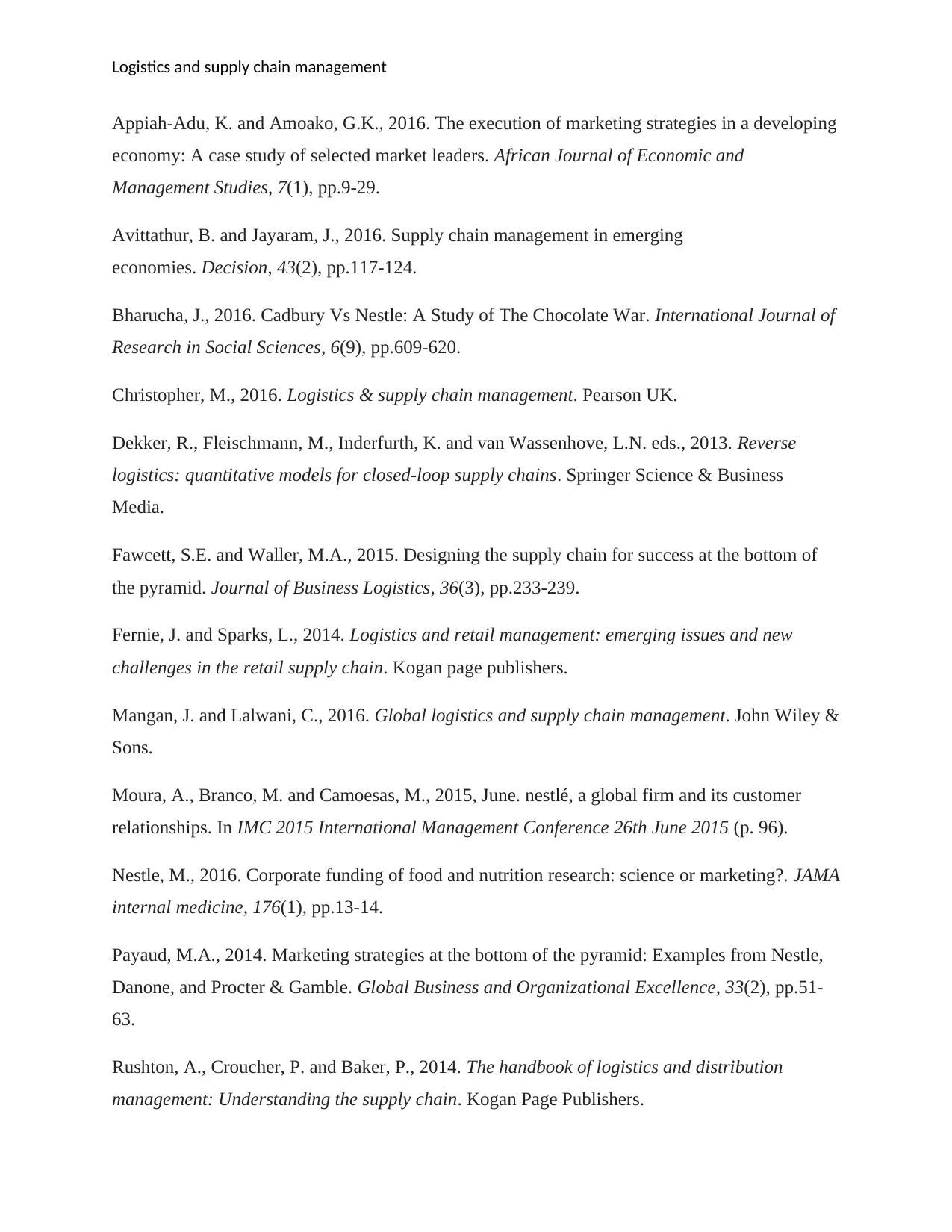
Logistics and supply chain management
Appiah-Adu, K. and Amoako, G.K., 2016. The execution of marketing strategies in a developing
economy: A case study of selected market leaders. African Journal of Economic and
Management Studies, 7(1), pp.9-29.
Avittathur, B. and Jayaram, J., 2016. Supply chain management in emerging
economies. Decision, 43(2), pp.117-124.
Bharucha, J., 2016. Cadbury Vs Nestle: A Study of The Chocolate War. International Journal of
Research in Social Sciences, 6(9), pp.609-620.
Christopher, M., 2016. Logistics & supply chain management. Pearson UK.
Dekker, R., Fleischmann, M., Inderfurth, K. and van Wassenhove, L.N. eds., 2013. Reverse
logistics: quantitative models for closed-loop supply chains. Springer Science & Business
Media.
Fawcett, S.E. and Waller, M.A., 2015. Designing the supply chain for success at the bottom of
the pyramid. Journal of Business Logistics, 36(3), pp.233-239.
Fernie, J. and Sparks, L., 2014. Logistics and retail management: emerging issues and new
challenges in the retail supply chain. Kogan page publishers.
Mangan, J. and Lalwani, C., 2016. Global logistics and supply chain management. John Wiley &
Sons.
Moura, A., Branco, M. and Camoesas, M., 2015, June. nestlé, a global firm and its customer
relationships. In IMC 2015 International Management Conference 26th June 2015 (p. 96).
Nestle, M., 2016. Corporate funding of food and nutrition research: science or marketing?. JAMA
internal medicine, 176(1), pp.13-14.
Payaud, M.A., 2014. Marketing strategies at the bottom of the pyramid: Examples from Nestle,
Danone, and Procter & Gamble. Global Business and Organizational Excellence, 33(2), pp.51-
63.
Rushton, A., Croucher, P. and Baker, P., 2014. The handbook of logistics and distribution
management: Understanding the supply chain. Kogan Page Publishers.
Appiah-Adu, K. and Amoako, G.K., 2016. The execution of marketing strategies in a developing
economy: A case study of selected market leaders. African Journal of Economic and
Management Studies, 7(1), pp.9-29.
Avittathur, B. and Jayaram, J., 2016. Supply chain management in emerging
economies. Decision, 43(2), pp.117-124.
Bharucha, J., 2016. Cadbury Vs Nestle: A Study of The Chocolate War. International Journal of
Research in Social Sciences, 6(9), pp.609-620.
Christopher, M., 2016. Logistics & supply chain management. Pearson UK.
Dekker, R., Fleischmann, M., Inderfurth, K. and van Wassenhove, L.N. eds., 2013. Reverse
logistics: quantitative models for closed-loop supply chains. Springer Science & Business
Media.
Fawcett, S.E. and Waller, M.A., 2015. Designing the supply chain for success at the bottom of
the pyramid. Journal of Business Logistics, 36(3), pp.233-239.
Fernie, J. and Sparks, L., 2014. Logistics and retail management: emerging issues and new
challenges in the retail supply chain. Kogan page publishers.
Mangan, J. and Lalwani, C., 2016. Global logistics and supply chain management. John Wiley &
Sons.
Moura, A., Branco, M. and Camoesas, M., 2015, June. nestlé, a global firm and its customer
relationships. In IMC 2015 International Management Conference 26th June 2015 (p. 96).
Nestle, M., 2016. Corporate funding of food and nutrition research: science or marketing?. JAMA
internal medicine, 176(1), pp.13-14.
Payaud, M.A., 2014. Marketing strategies at the bottom of the pyramid: Examples from Nestle,
Danone, and Procter & Gamble. Global Business and Organizational Excellence, 33(2), pp.51-
63.
Rushton, A., Croucher, P. and Baker, P., 2014. The handbook of logistics and distribution
management: Understanding the supply chain. Kogan Page Publishers.
⊘ This is a preview!⊘
Do you want full access?
Subscribe today to unlock all pages.

Trusted by 1+ million students worldwide
1 out of 13
Related Documents
Your All-in-One AI-Powered Toolkit for Academic Success.
+13062052269
info@desklib.com
Available 24*7 on WhatsApp / Email
![[object Object]](/_next/static/media/star-bottom.7253800d.svg)
Unlock your academic potential
Copyright © 2020–2025 A2Z Services. All Rights Reserved. Developed and managed by ZUCOL.





